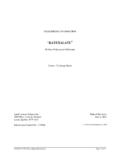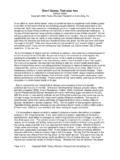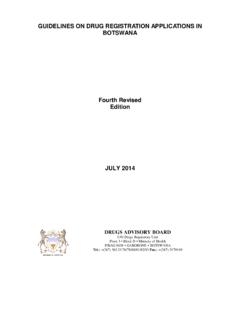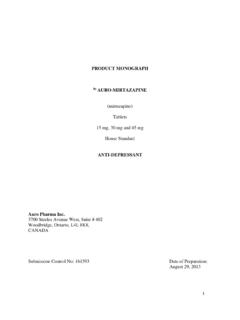Transcription of PRODUCT MONOGRAPH LANTUS - Sanofi
1 PRODUCT MONOGRAPH . LANTUS . insulin glargine injection (rDNA origin). Solution for injection 100 U/mL. ATC code: A10AE04. Antidiabetic Agent Long-acting Recombinant Human insulin Analogue Sanofi -aventis Canada Inc. Date of Revision: 2905 Place Louis October 19 2017. Laval, Quebec H7V 0A3. Submission Control No: 208392 s-a version dated October 17, 2017. Page 1 of 62. Table of Contents PART I: HEALTH PROFESSIONAL INFORMATION .. 3. SUMMARY PRODUCT INFORMATION .. 3. DESCRIPTION .. 3. INDICATIONS AND CLINICAL USE .. 3. CONTRAINDICATIONS .. 4. WARNINGS AND 4. ADVERSE REACTIONS .. 10. DRUG INTERACTIONS .. 16. DOSAGE AND ADMINISTRATION .. 17. OVERDOSAGE .. 19. ACTION AND CLINICAL PHARMACOLOGY .. 20. STORAGE AND 23. SPECIAL HANDLING INSTRUCTIONS .. 24. DOSAGE FORMS, COMPOSITION AND PACKAGING .. 24. PART II: SCIENTIFIC INFORMATION .. 26. PHARMACEUTICAL INFORMATION .. 26. CLINICAL TRIALS .. 27. DETAILED PHARMACOLOGY .. 34. TOXICOLOGY.
2 34. REFERENCES .. 36. PART III: CONSUMER 39. PART III: CONSUMER 47. PART III: CONSUMER 55. Page 2 of 62. PRODUCT MONOGRAPH . LANTUS . insulin glargine injection (rDNA origin). Antidiabetic Agent Long-acting Recombinant Human insulin Analogue PART I: HEALTH PROFESSIONAL INFORMATION. SUMMARY PRODUCT INFORMATION. Route of Dosage Form / Clinically Relevant Nonmedicinal Administration Strength Ingredients Subcutaneous Solution for injection glycerol 85%, m-cresol, polysorbate 20. 100 U/mL (10 mL vial only), zinc, and water for injection. Hydrochloric acid and sodium hydroxide for pH adjustment. DESCRIPTION. LANTUS [ insulin glargine injection (rDNA origin)] is a recombinant human insulin analogue that is a long-acting, parenteral blood-glucose-lowering agent. LANTUS is produced by recombinant DNA technology utilizing a non-pathogenic laboratory strain of Escherichia coli (K12) as the production organism. insulin glargine differs from natural human insulin in that the amino acid asparagine at position 21 of the A-chain is replaced by glycine and two arginines are added to the C-terminus of the B- chain (see PHARMACEUTICAL INFORMATION, Drug Substance).
3 INDICATIONS AND CLINICAL USE. LANTUS [ insulin glargine injection (rDNA origin)] is a recombinant human insulin analog indicated for once-daily subcutaneous administration in the treatment of patients over 17 years of age with Type 1 or Type 2 diabetes mellitus who require basal (long-acting) insulin for the control of hyperglycemia. Page 3 of 62. LANTUS is also indicated in the treatment of pediatric patients ( 6 years old) with Type 1. diabetes mellitus who require basal (long-acting) insulin for the control of hyperglycemia. CONTRAINDICATIONS. LANTUS [ insulin glargine injection (rDNA origin)] is contraindicated in patients who are hypersensitive to this drug or to any ingredient in the formulation or component of the container. For a complete listing, see DOSAGE FORMS, COMPOSITION AND PACKAGING. WARNINGS AND PRECAUTIONS. Serious Warnings and Precautions Hypoglycemia is the most common adverse effect of insulin , including LANTUS (see WARNINGS AND PRECAUTIONS, Endocrine and Metabolism, Hypoglycemia).
4 As with all insulins, the timing of hypoglycemia may differ among various insulin formulations. Glucose monitoring is recommended for all patients with diabetes. Uncorrected hypoglycemic or hyperglycemic reactions can cause loss of consciousness, coma, or death. Any change of insulin should be made cautiously and only under medical supervision. LANTUS is not intended for intravenous or intramuscular administration. The prolonged duration of activity of insulin glargine is dependent on injection into subcutaneous tissue. Intravenous administration of the usual subcutaneous dose could result in severe hypoglycemia. LANTUS must not be mixed with any other insulin or diluted with any other solution. If LANTUS is diluted or mixed, the solution may become cloudy, and the pharmacokinetic/. pharmacodynamic profile ( , onset of action, time to peak effect) of LANTUS and/or the mixed insulin may be altered in an unpredictable manner (see DOSAGE AND.)
5 ADMINISTRATION). This insulin PRODUCT shall not be used if it is not water-clear and colourless or if it has formed a deposit of solid particles on the wall of the vial or cartridge (see DOSAGE AND. ADMINISTRATION). General As with all insulin preparations, the time course of LANTUS action may vary in different individuals or at different times in the same individual and the rate of absorption is dependent on blood supply, temperature, and physical activity. Page 4 of 62. Hypokalemia is among the potential clinical adverse effect associated with the use of all insulin therapies, particularly when given intravenously. However, LANTUS should not be given intravenously (see DOSAGE AND ADMINISTRATION, Administration). If left untreated, hypokalemia may cause respiratory paralysis, ventricular arrhythmia, and death. This potential clinical adverse effect may be more relevant in patients who are at risk for hypokalemia ( , patient using potassium lowering drugs), patients taking medications sensitive to serum potassium concentrations, or patients losing potassium through other means ( diarrhea).
6 Stress or concomitant illness, especially infectious and febrile conditions may change insulin requirements. insulin may cause sodium retention and edema, particularly if previously poor metabolic control is improved by intensified insulin therapy. Patients with human insulin antibodies may be hypersensitive to other insulins, with a risk of hypoglycemia and/or cross-reactivity. Thiazolidinediones (TZDs), alone or in combination with other antidiabetic agents (including insulin ), can cause heart failure and edema. The combination of TZD with insulin is not indicated for the treatment of Type 2 Diabetes Mellitus. Please refer to the respective TZD. PRODUCT MONOGRAPH WARNINGS AND PRECAUTIONS information when the use of these drugs in combination with any insulin , including LANTUS , is contemplated. To avoid transmission of disease, cartridge or a prefilled syringe shall not be used by more than one person. Accidental mix-ups between insulin glargine and other insulins, particularly short-acting insulins, have been reported.
7 To avoid medication errors between insulin glargine and other insulins, patients should be instructed to always check the insulin label before each injection (see ADVERSE REACTIONS). Endocrine and Metabolism Hypoglycemia: As with all insulin preparations, hypoglycemic reactions, especially during initiation of therapy, may be associated with the administration of LANTUS . Hypoglycemia is the most common adverse effect of insulins (see ADVERSE REACTIONS). Hypoglycemia may occur if the insulin dose is too high in relation to the insulin requirement (see OVERDOSAGE). Early warning symptoms of hypoglycemia may be different, be less pronounced or absent under certain conditions, as for example, in patients whose glycemic control is markedly improved, in elderly patients, in patients where an autonomic neuropathy is present, in patients whose hypoglycemia is developing gradually, in patients with a long history of diabetes, in patients with psychiatric illness, or in patients receiving concurrent treatment with certain other drugs such as beta-blockers.
8 Hypoglycemia may occur with other substances including alcohol and psychiatric Page 5 of 62. medications, street drugs, birth control pills, injections and patches (see DRUG. INTERACTIONS: Drug-Drug Interactions). Such situations may result in severe hypoglycemia (and possibly, loss of consciousness) prior to patients' awareness of hypoglycemia. The time of occurrence of hypoglycemia depends on the action profile of the insulins used and may, therefore, change when the treatment regimen or timing of administration is changed. As with all insulins, prolonged or severe hypoglycemic attacks, especially if recurrent, may lead to neurological damage, loss of consciousness, coma or death (see ADVERSE REACTIONS). As with all insulins, additional caution (including intensified blood glucose monitoring) should be exercised in patient populations who are at greater risk for clinically significant sequelae from hypoglycemic episodes.
9 In a clinical study, symptoms of hypoglycemia or counter regulatory hormone responses were similar after intravenous insulin glargine and regular human insulin both in healthy subjects and adult patients with type 1 diabetes. Hypoglycemic reactions following treatment with insulin products such as LANTUS are mostly mild and easily managed. Changes in insulin therapy or changes in life style ( diet, omission of a meal, exercise/ physical activity) may require a change in dosage to avoid hypoglycemia. Glucose monitoring is recommended for all patients with diabetes. Diabetic patients should be instructed to carry a few lumps of sugar, candies or biscuits to prevent the progression of a hypoglycemic reaction, should one occur (see PART III: CONSUMER INFORMATION). Hyperglycemia: The use of too low insulin dosages or discontinuation of treatment, especially in Type 1 diabetes, may lead to hyperglycemia and diabetic ketoacidosis.
10 Uncorrected hyperglycemic reactions can cause loss of consciousness, coma, or death. Immune Injection Site and Local Allergic Reactions: As with any insulin therapy, lipodystrophy may occur at the injection site and delay insulin absorption. Other injection site reactions with insulin therapy include redness, pain, itching at the injection site, hives, swelling, and inflammation. Continuous rotation of the injection site within a given area may help to reduce or prevent these reactions. Most minor reactions to insulins usually resolve in a few days to a few weeks. They may occur if the injection is not properly Page 6 of 62. made (irritants in the skin cleansing agent or poor injection technique), or if the patient is allergic to the insulin or any excipients. Rarely, SC administration of insulin products can result in lipoatrophy (depression in the skin) or lipohypertrophy (enlargement or thickening of tissue). Patients should be advised to consult their doctor if they notice any of these conditions.



![Thymoglobulin (anti-thymocyte globulin [rabbit]) - …](/cache/preview/a/b/2/e/e/b/8/2/thumb-ab2eeb82468088f352549e7d8dab340f.jpg)







![[Product Monograph Template - Schedule D]](/cache/preview/b/f/c/5/9/9/f/5/thumb-bfc599f58969b8bff3fb0f7d9d95ed1e.jpg)



